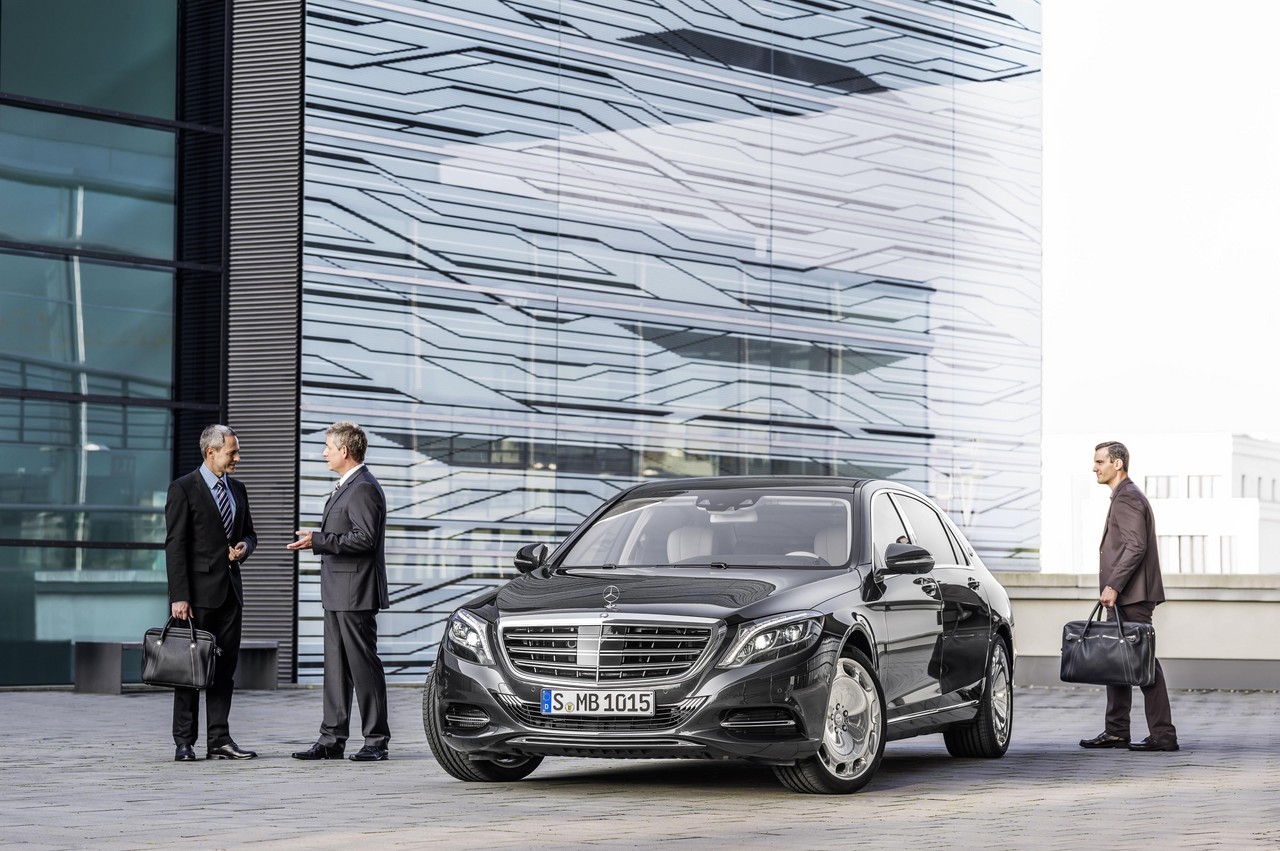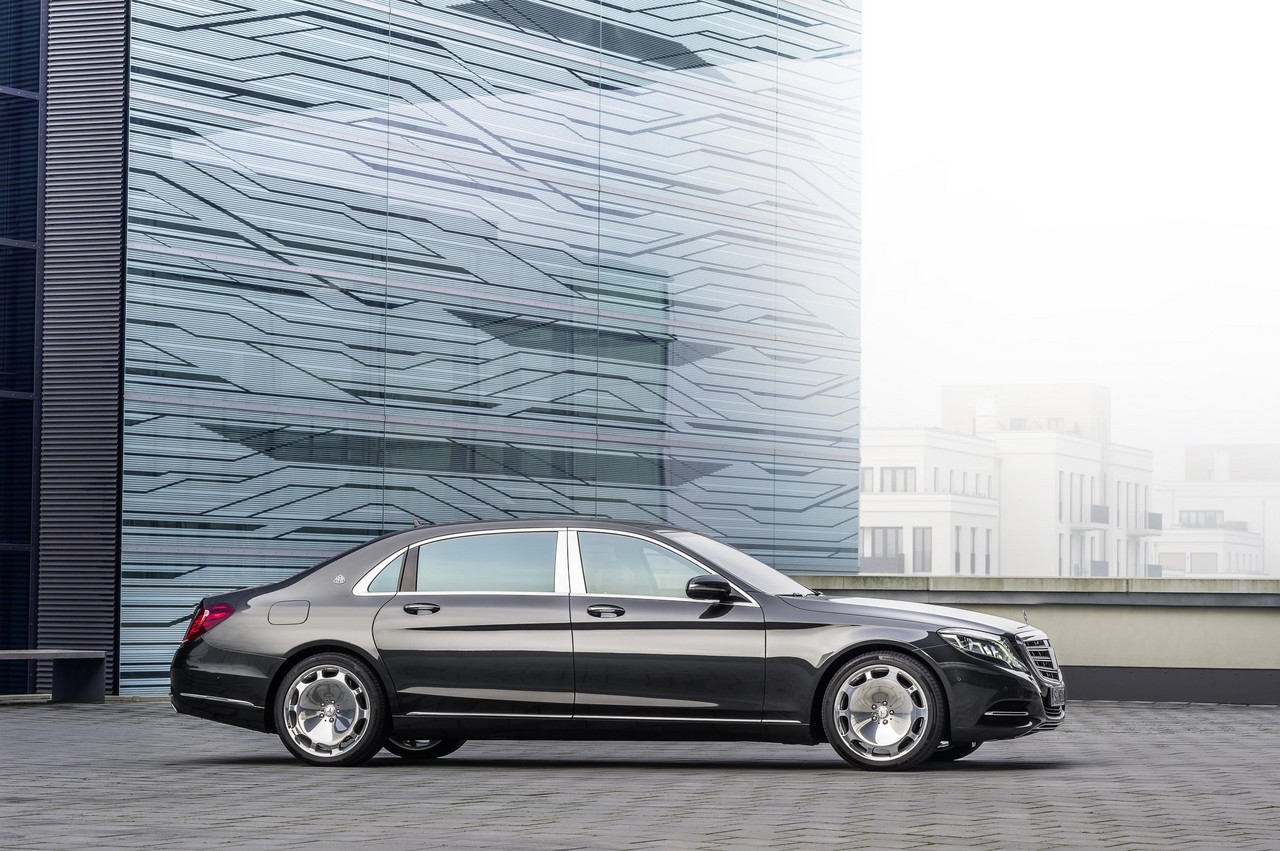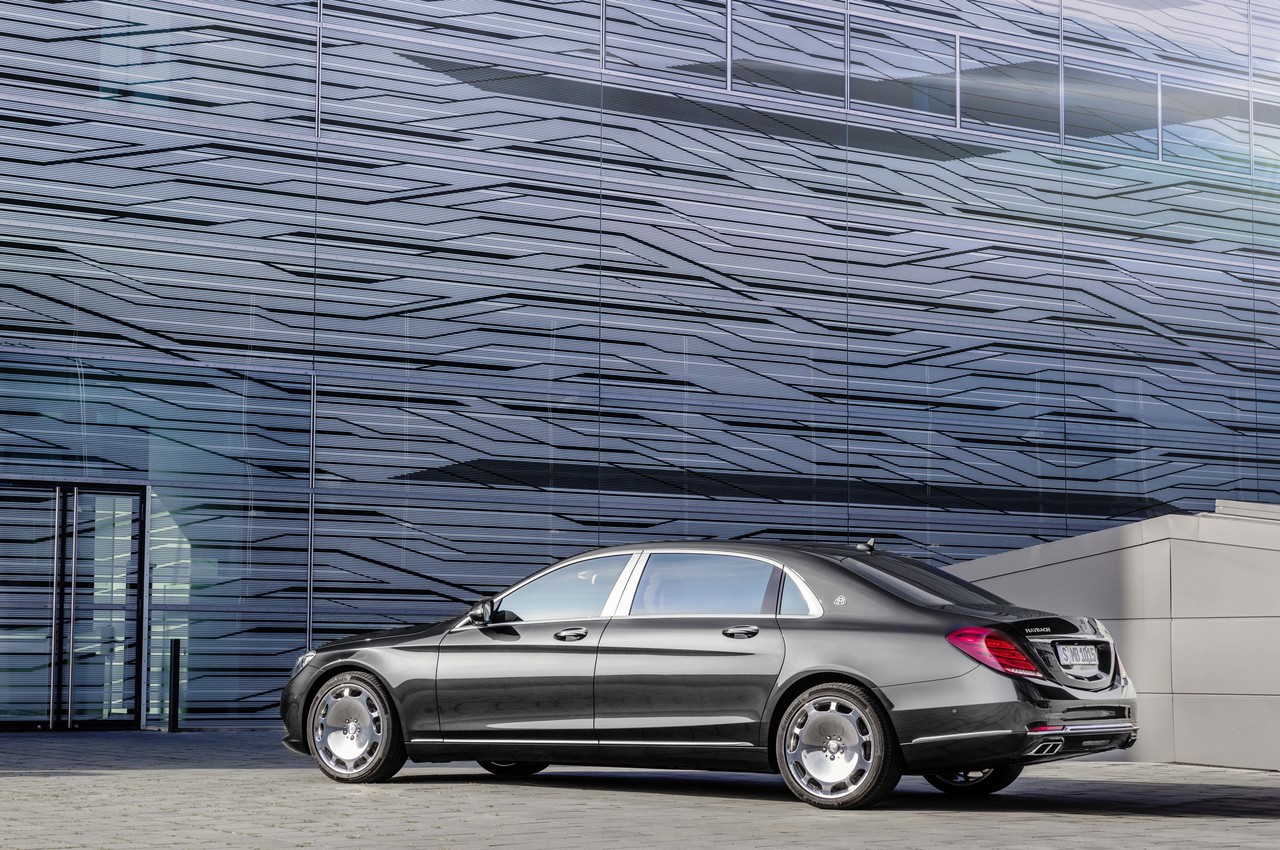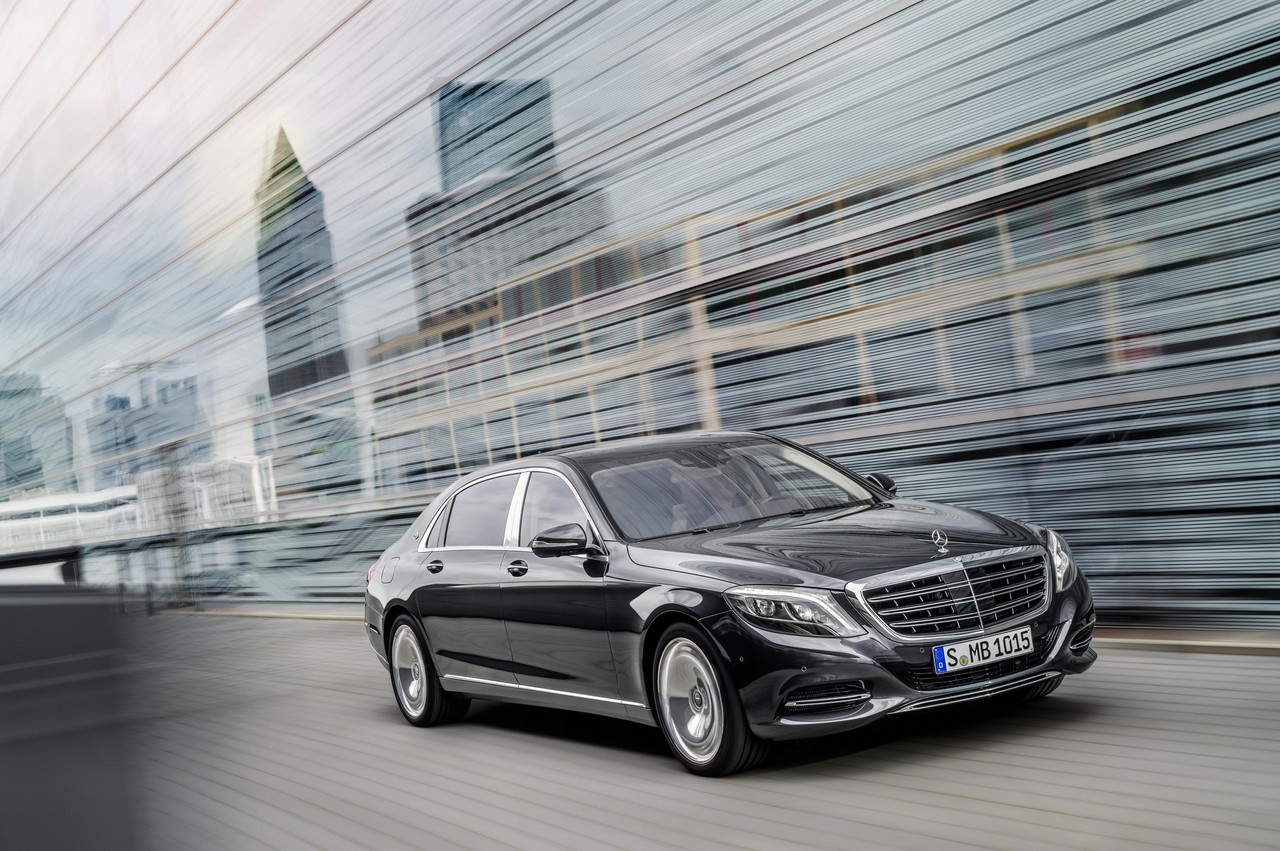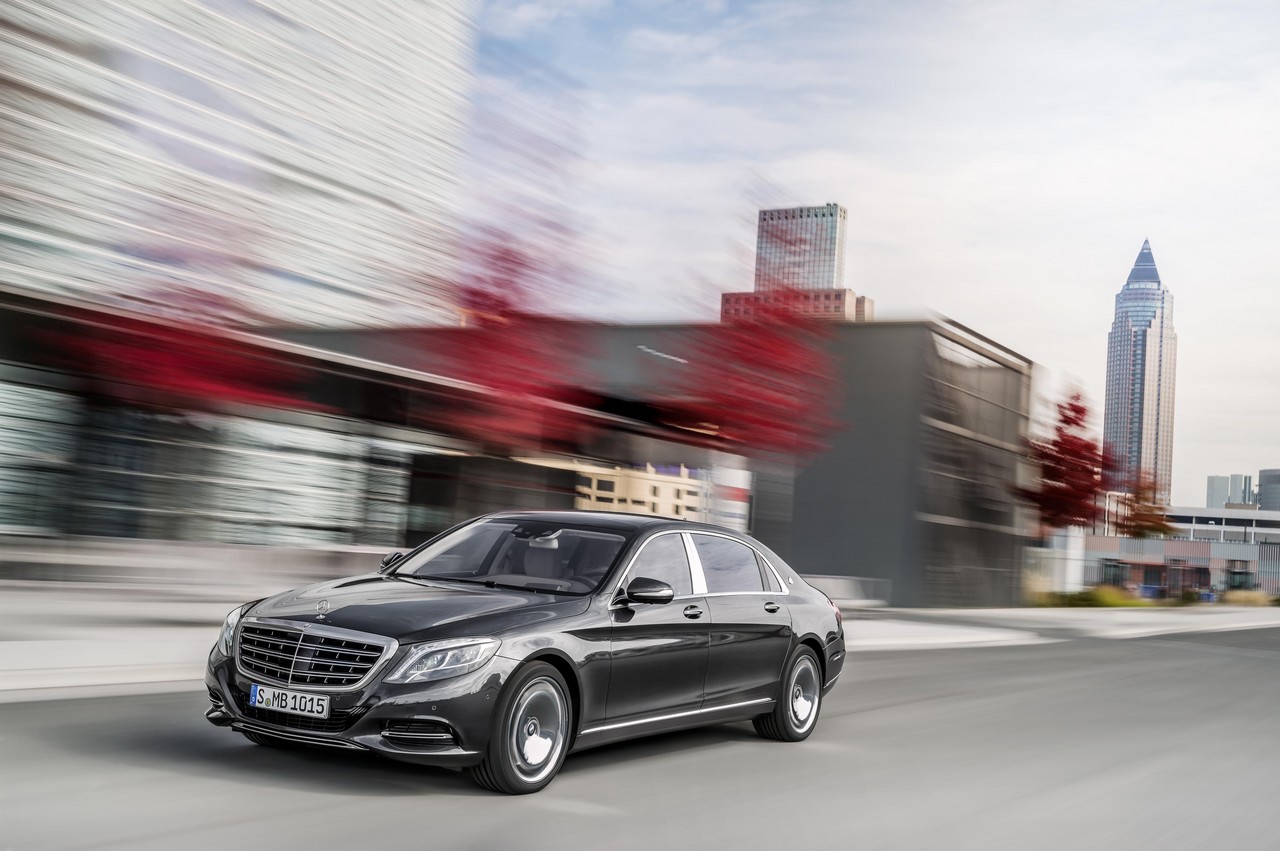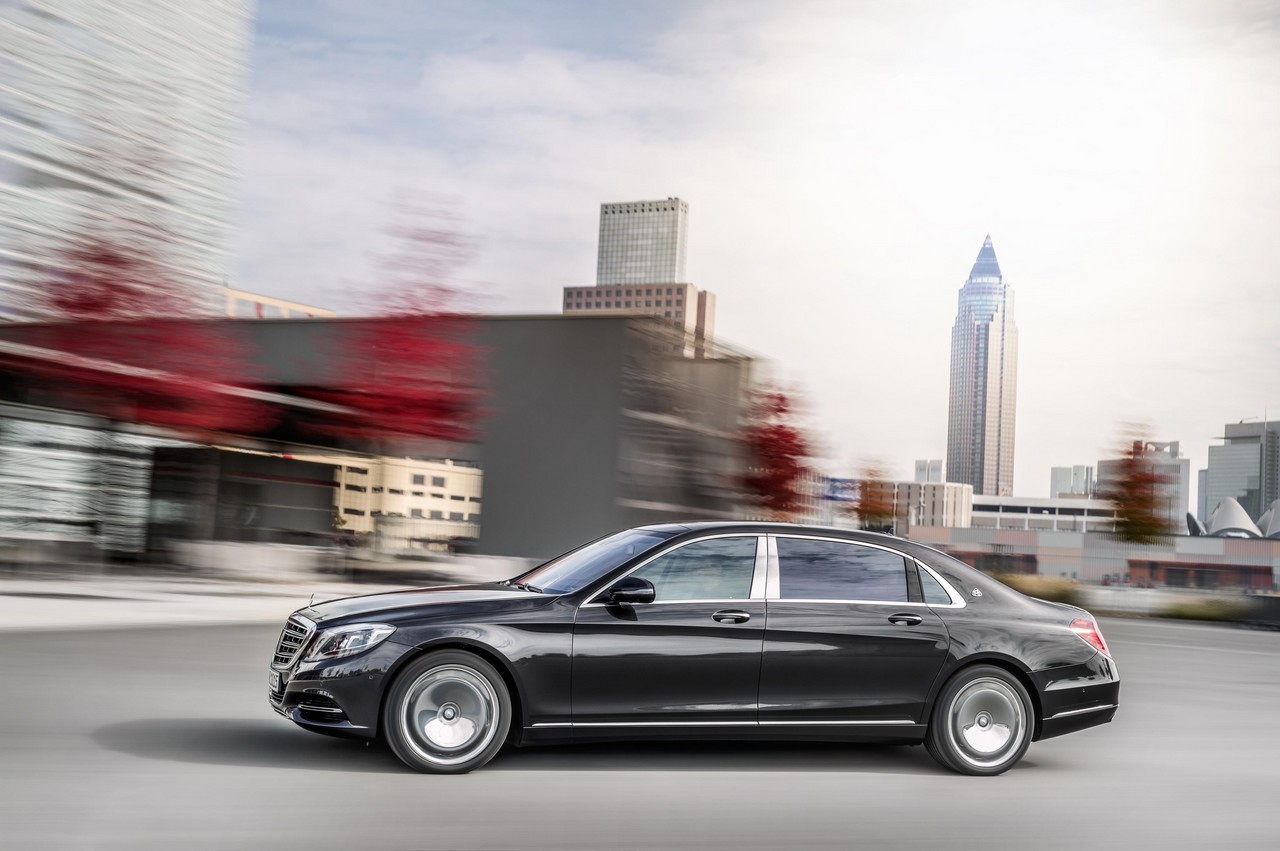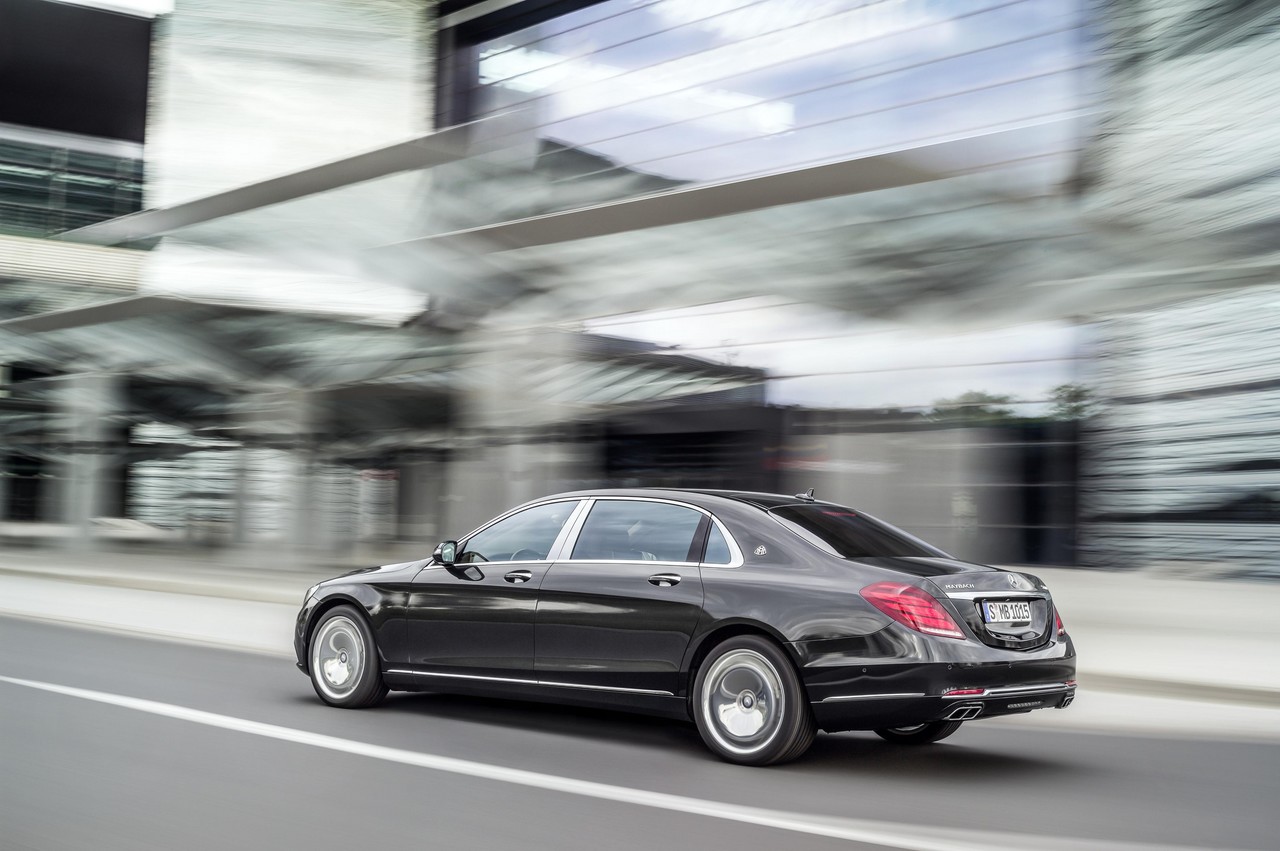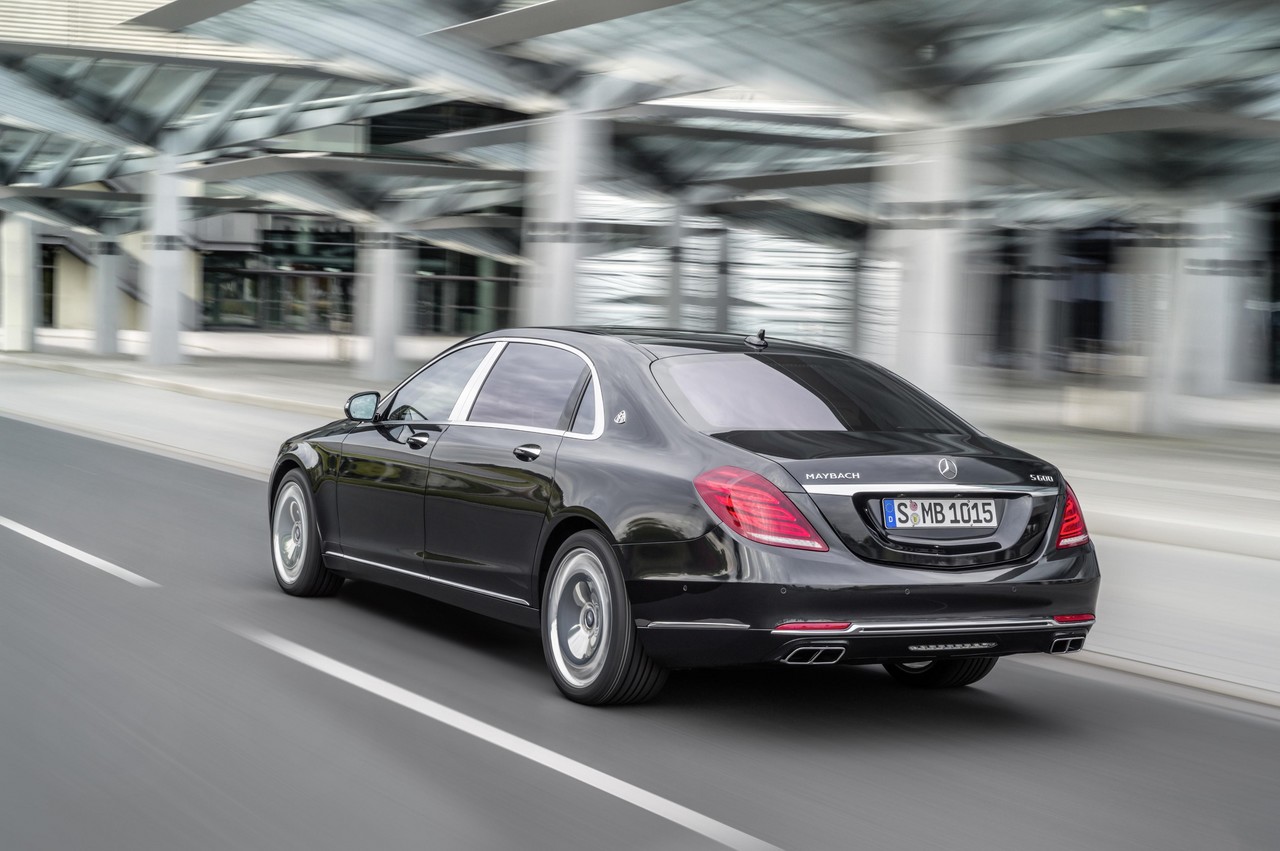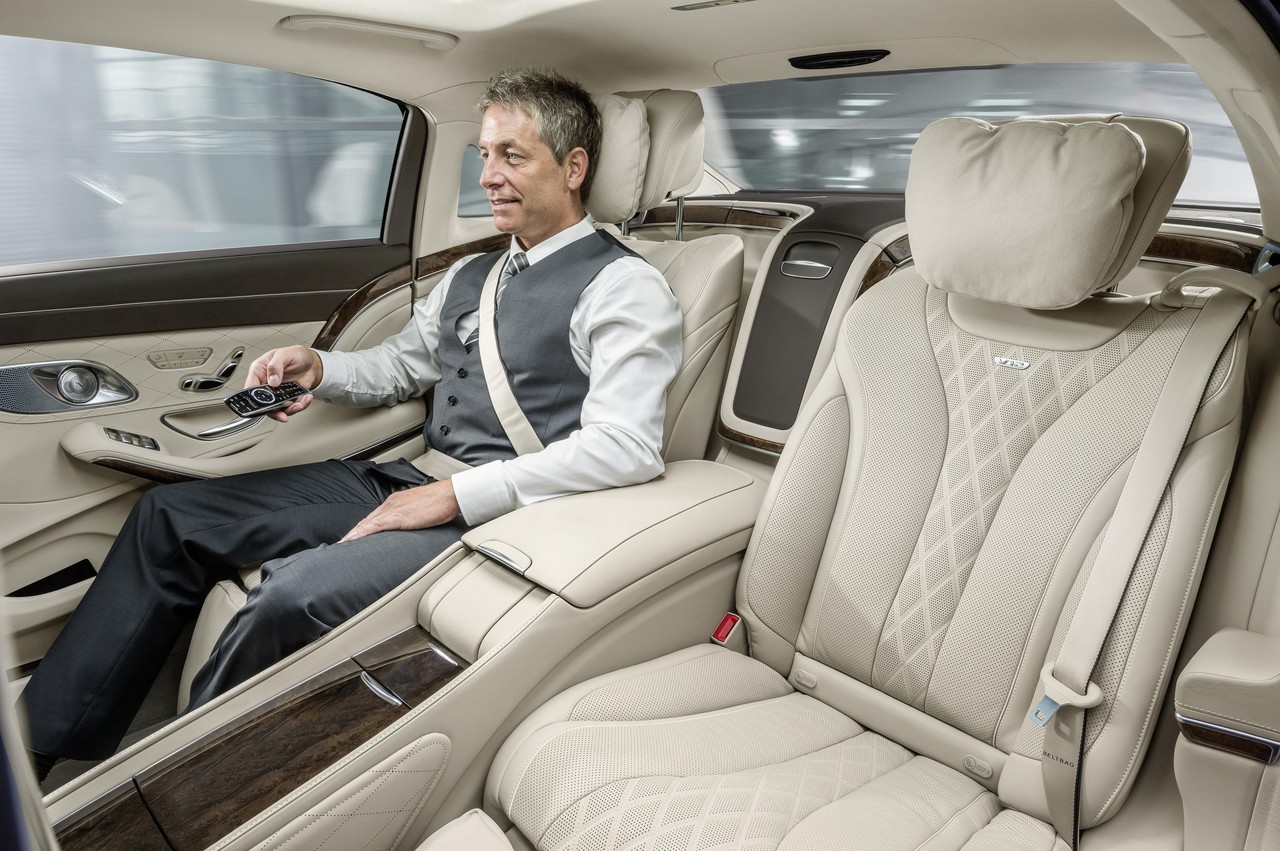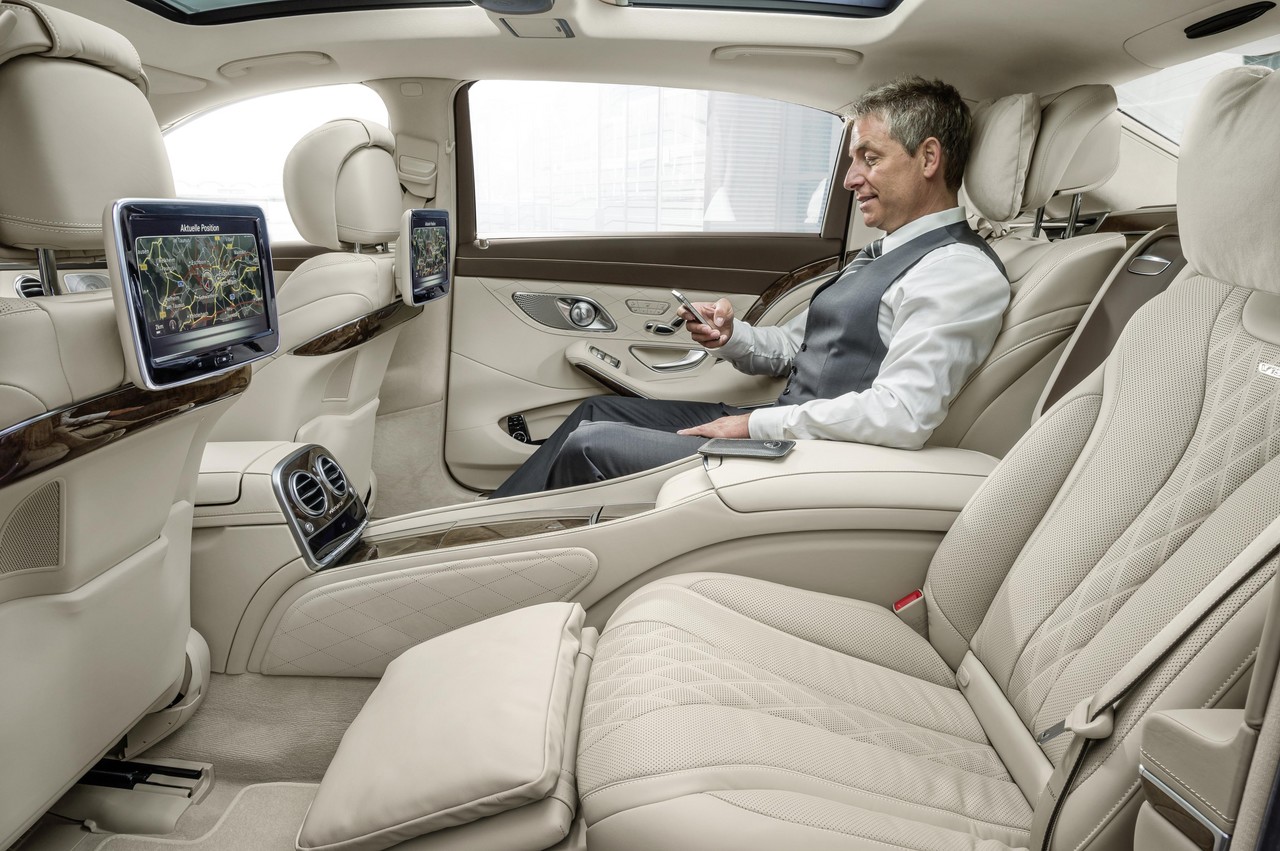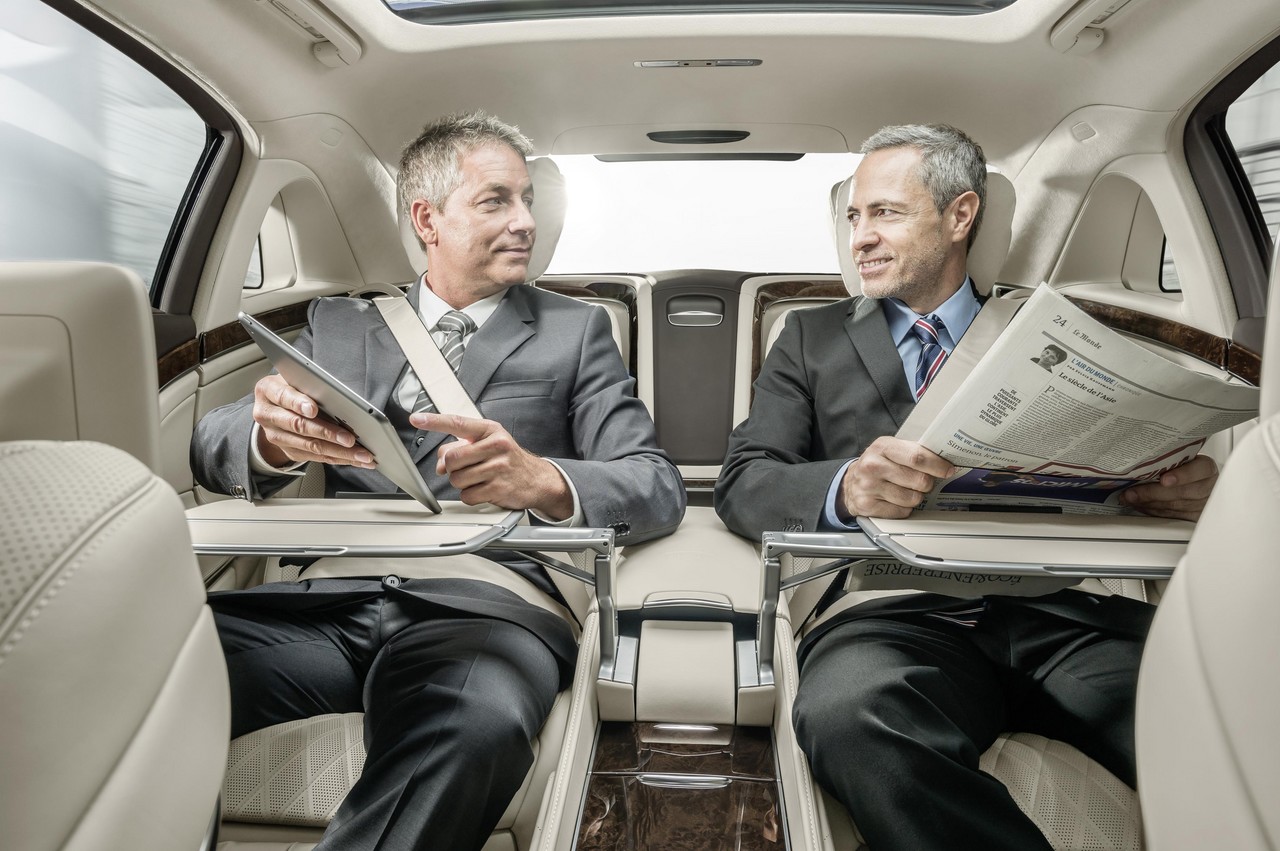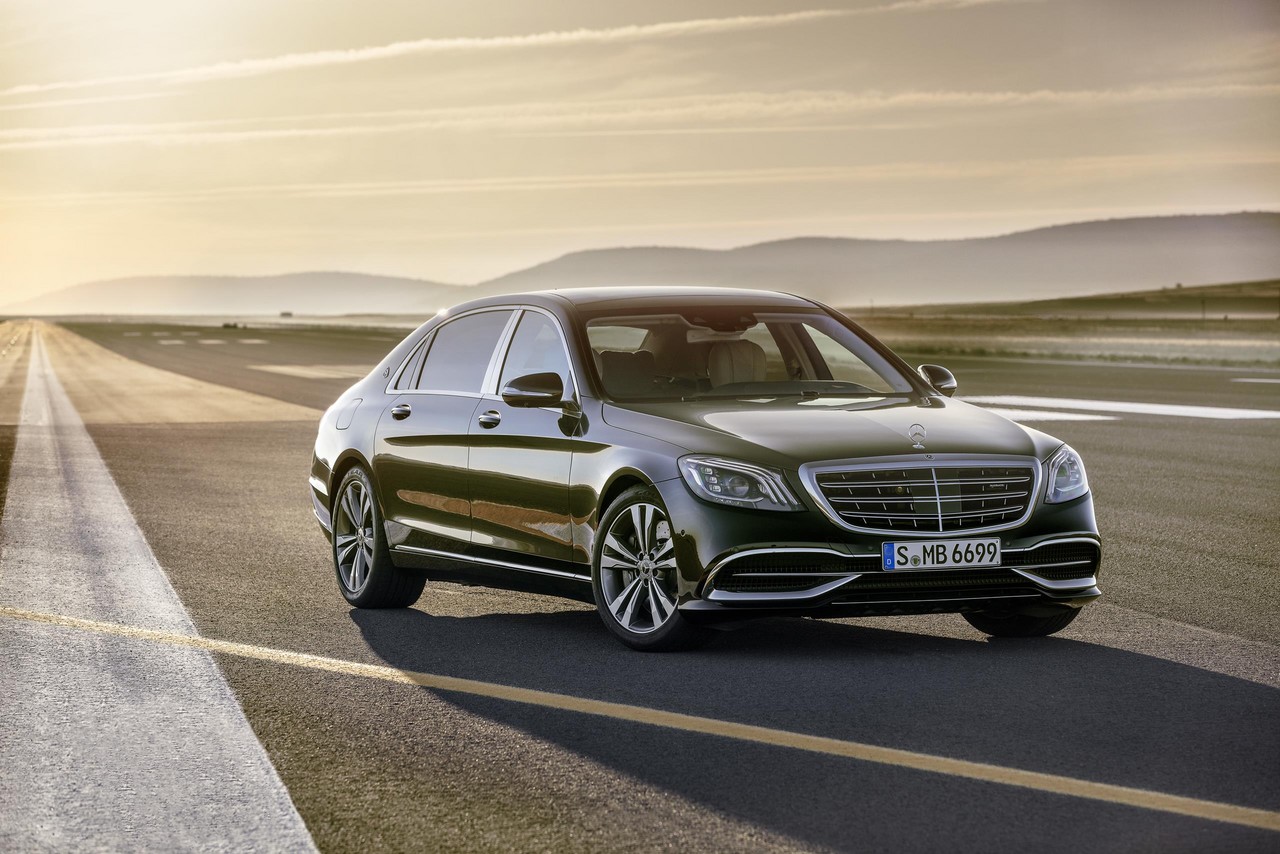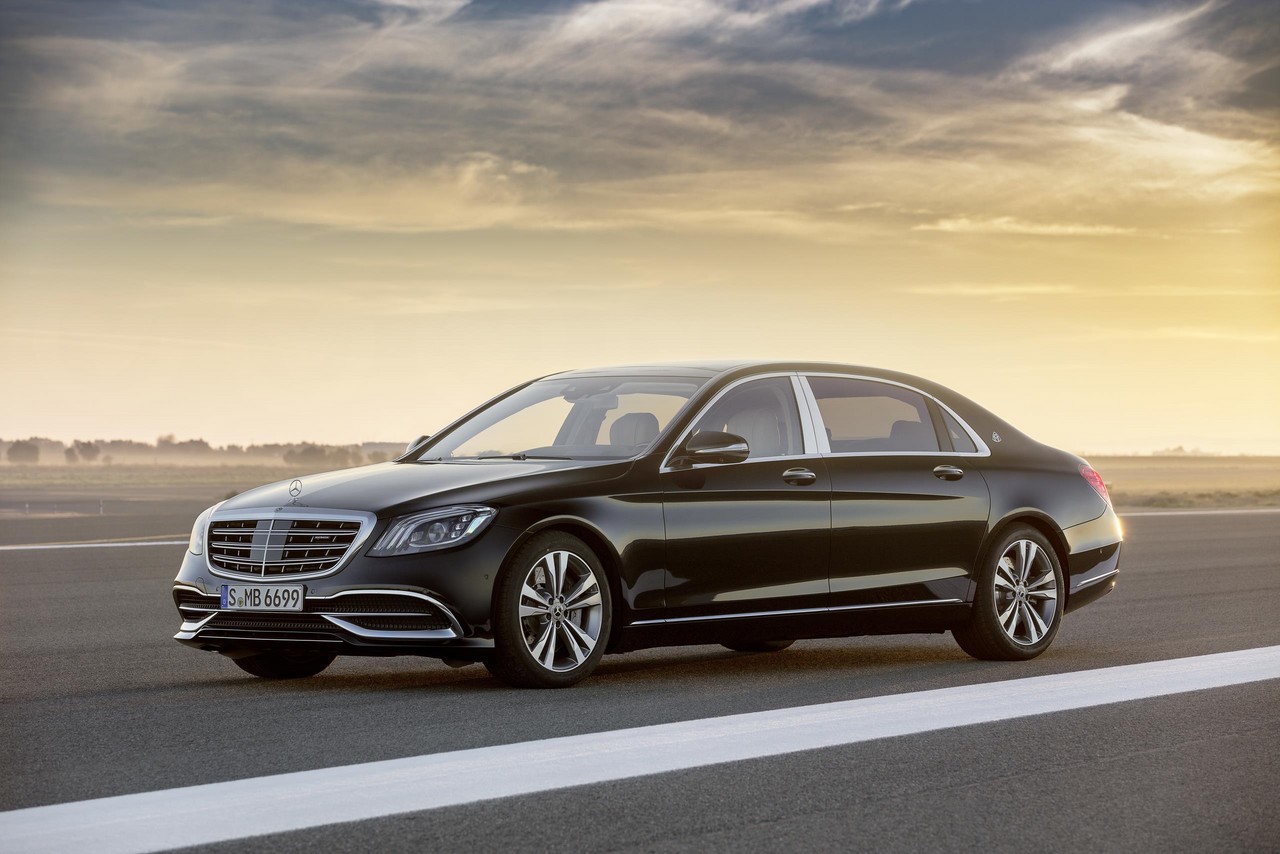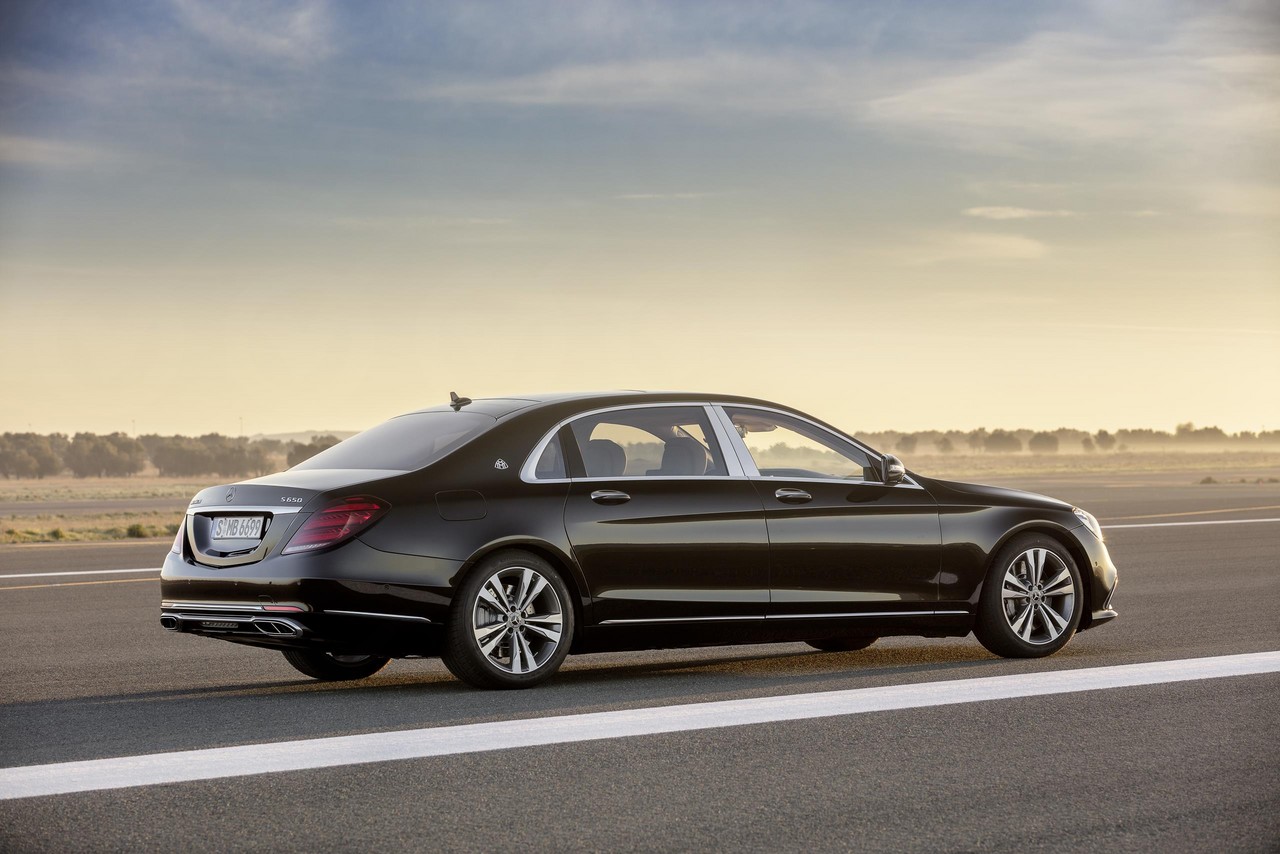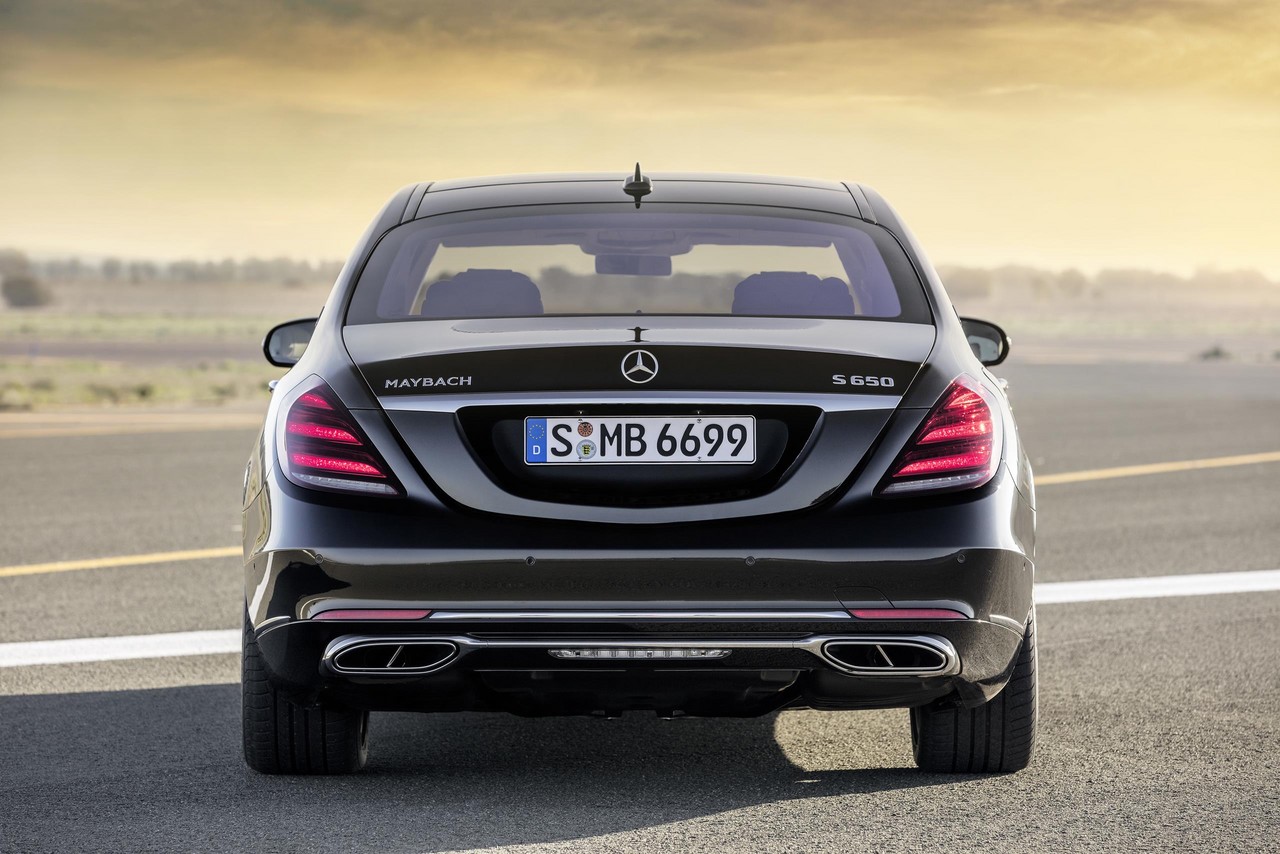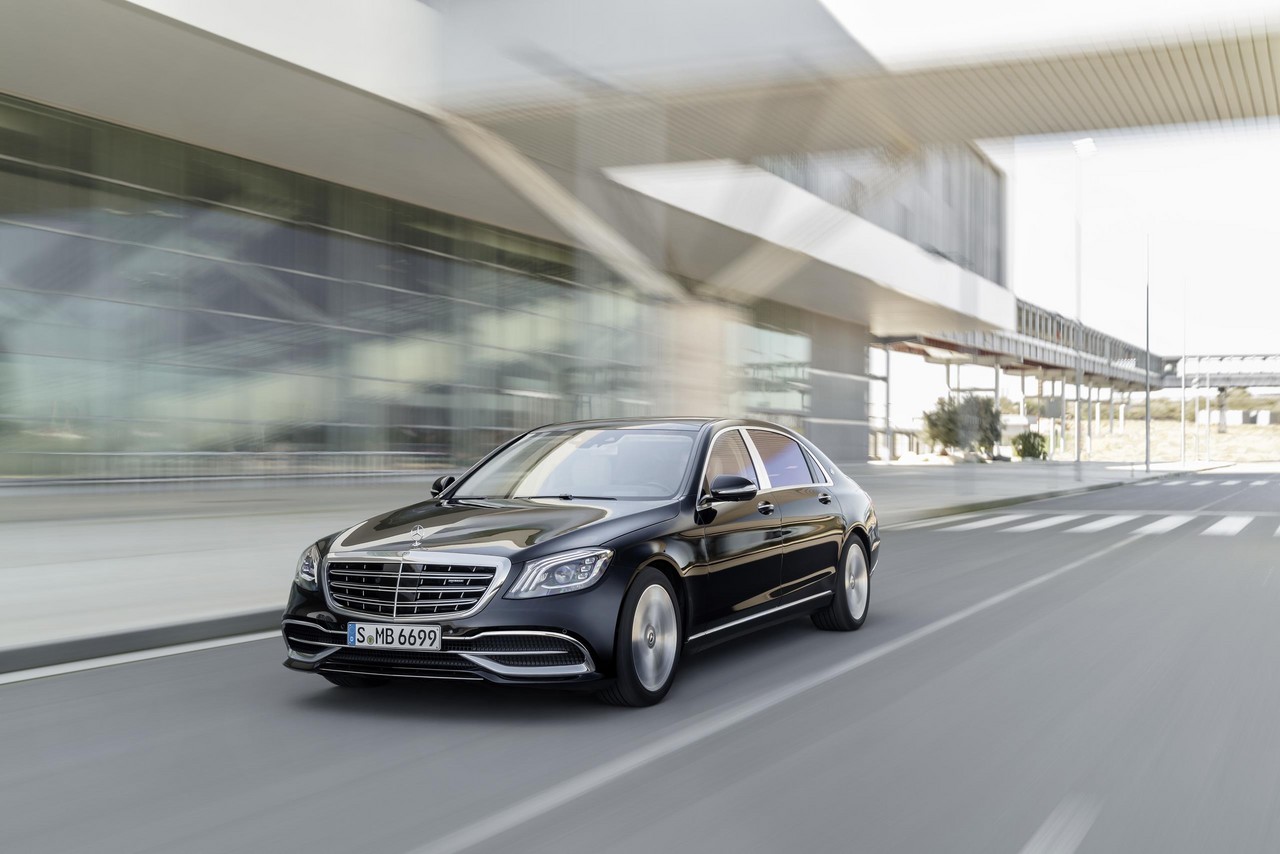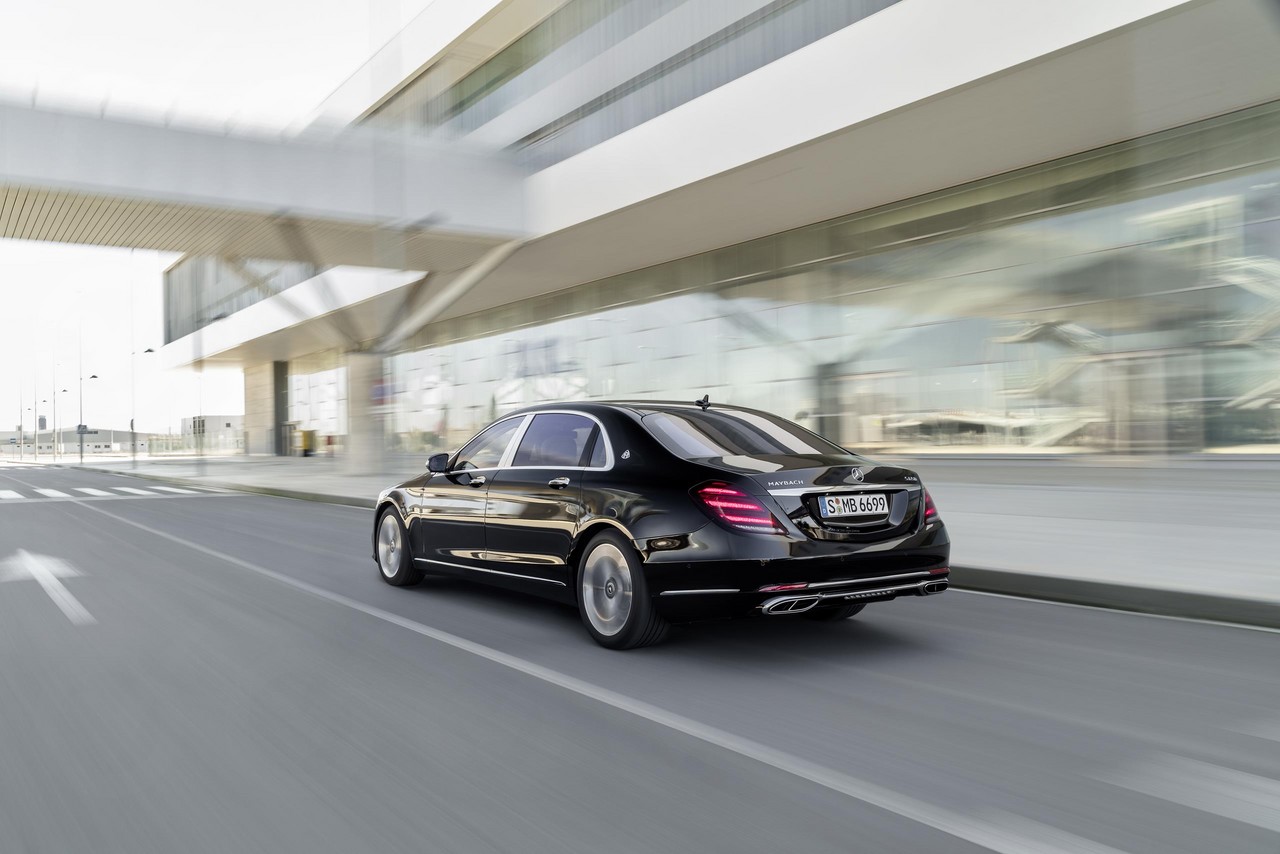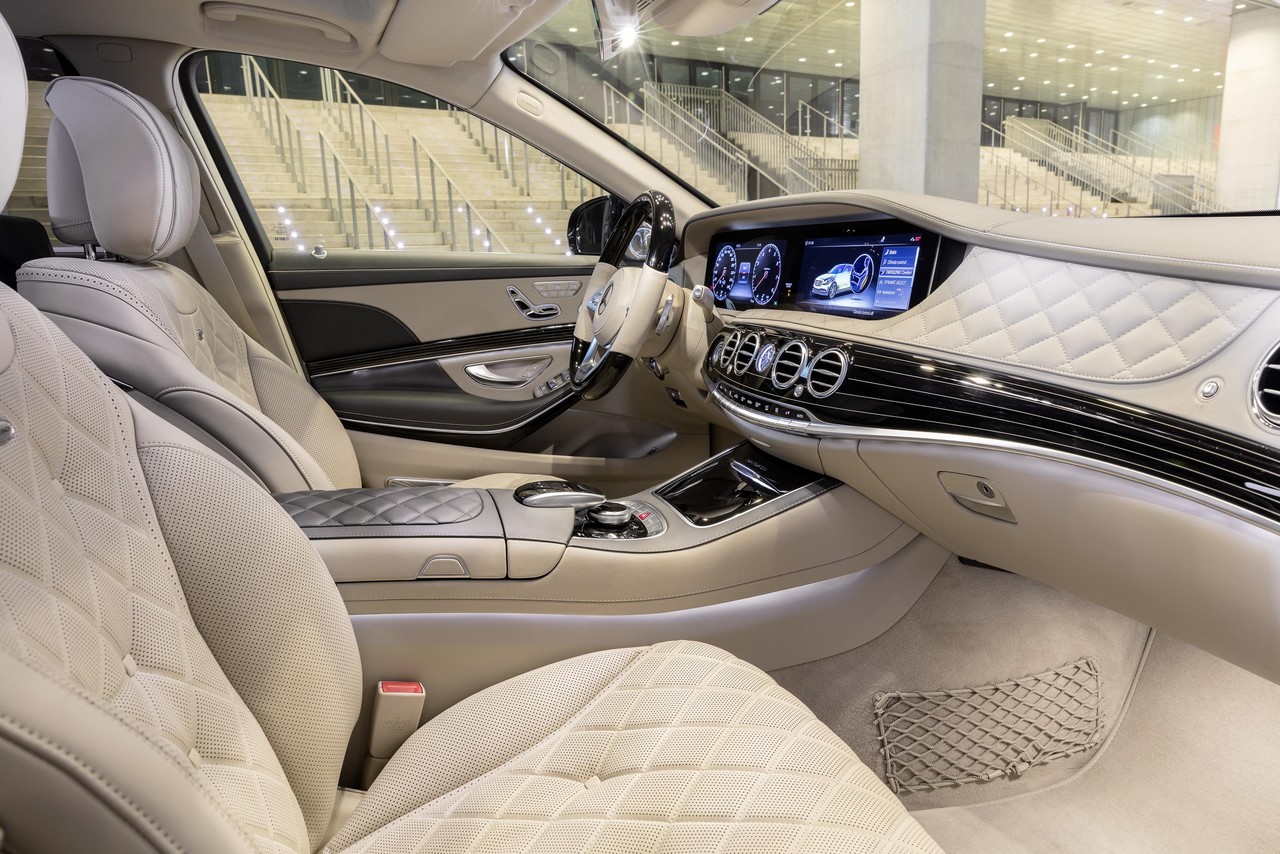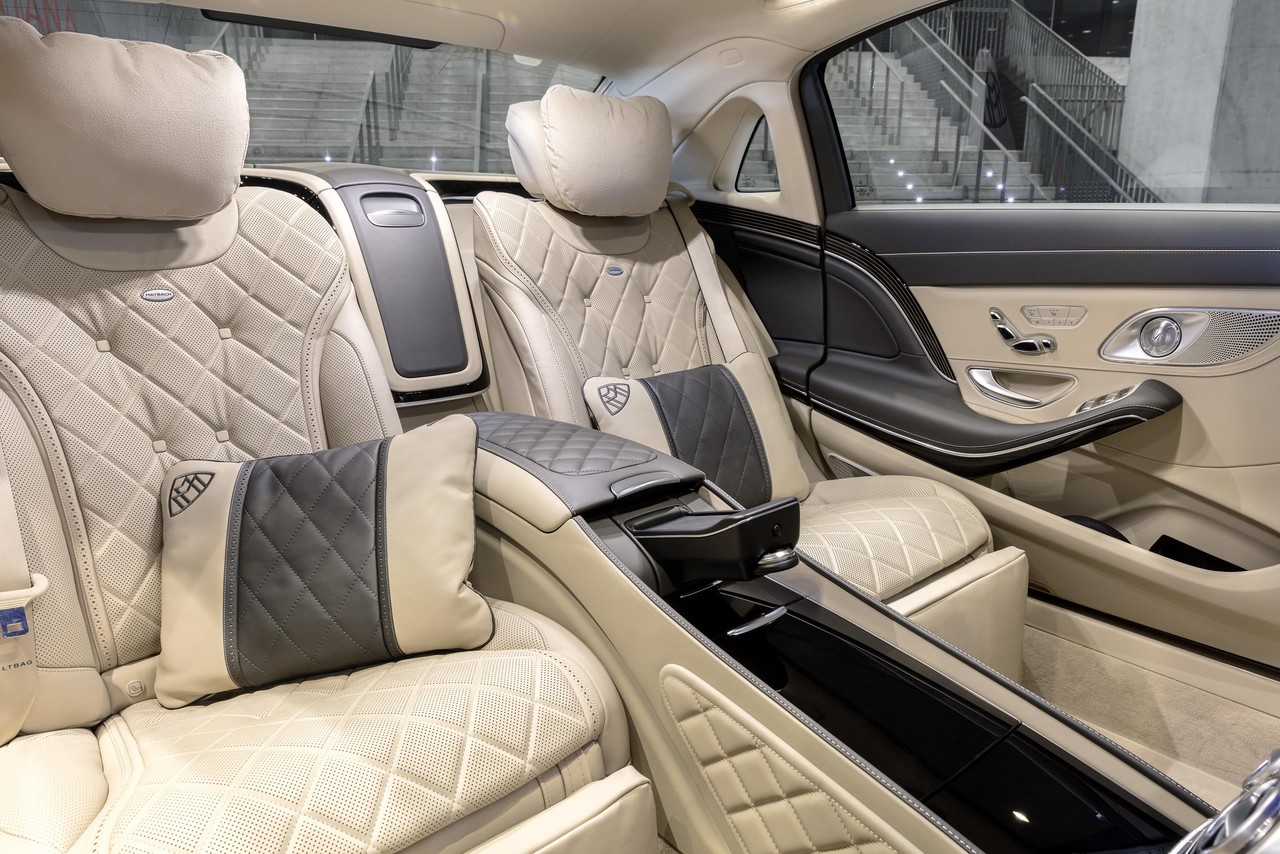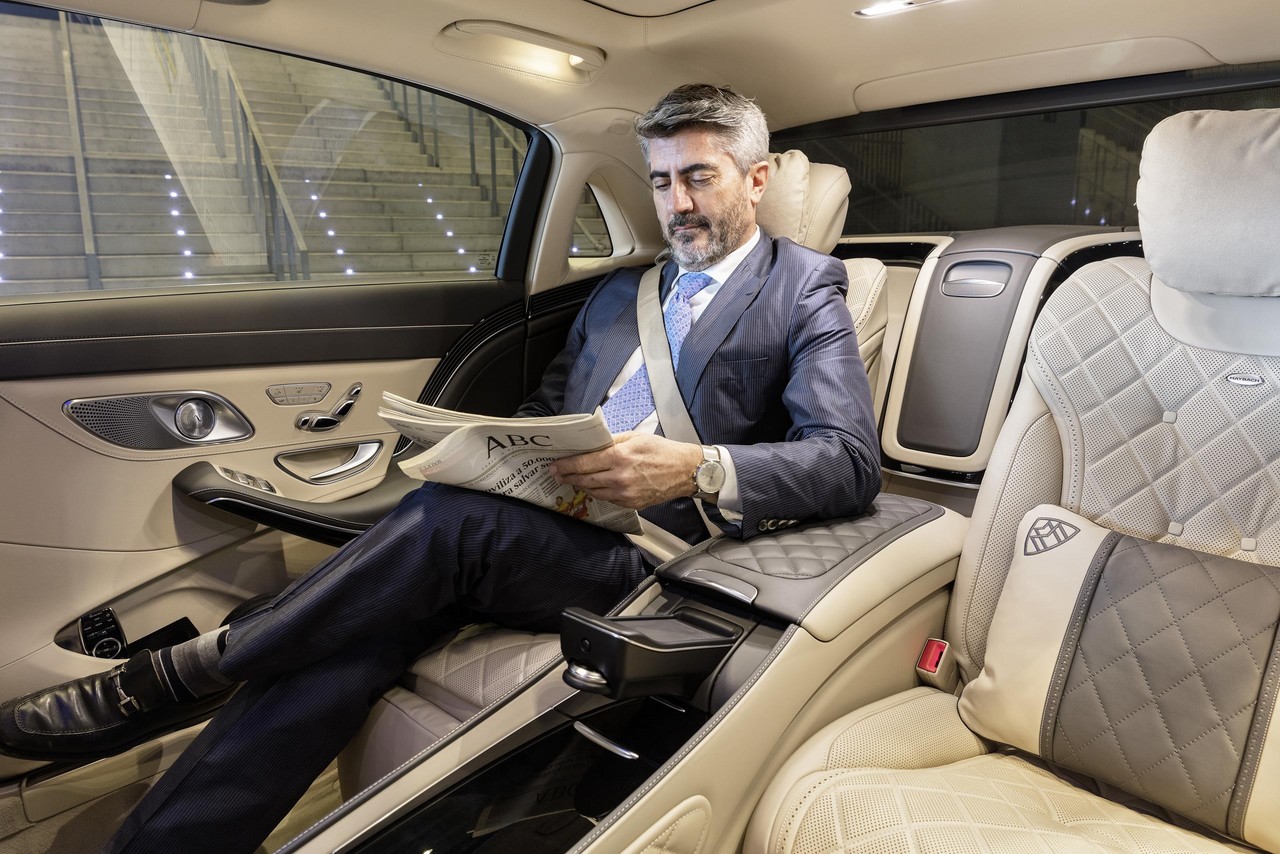
- Excellent ride/handling balance
- Impressively quiet cabin has supremely comfortable seats
- Engaging steering
- Low profile tyres hurt ride quality
- Magic Ride Control not faultless
- Lack of differentiation from Mercedes-Benz W222/V222 S-Class
- High running, maintenance and depreciation costs
Mercedes-Maybach X222 S 600 (2015-17)
Overview
Available to order from May 2015, the Mercedes-Maybach X222 S-Class was a long wheelbase, prestige saloon. Manufactured in Sindelfingen, Germany, the Mercedes-Maybach X222 S 600 was powered by a 6.0-litre M279 biturbo V12 petrol engine that was mated to a seven-speed automatic transmission.
The X222 S-Class was the first vehicle from the Mercedes-Maybach sub-brand.
| Engine | Trans. | Peak power | Peak torque | |
|---|---|---|---|---|
| S 600 | 6.0-litre twin-turbo petrol V12 (M279 E60 AL) | 7sp auto | 390 kW at 4900-5300 rpm | 830 Nm at 1900-4000 rpm |
Body and dimensions
Developed in conjunction with the W222 S-Class , the Mercedes-Maybach X222 S-Class had a hybrid steel/aluminium body which used manufacturing techniques such as aluminium MIG welding, self-piercing riveting and the first use of RobScan welding on aluminium in large-scale production.
Compared to the Mercedes-Benz V222 S-Class , the wheelbase of the Mercedes-Maybach X222 S-Class was extended by 200 mm and the rear doors shortened by 66 mm. As such, the Mercedes-Maybach X222 S-Class was 5457 mm long, 1899 mm wide, 1500 mm tall and had a 3365 mm long wheelbase. Inside, the rear seats were situated beyond the rear door line to create ‘a feeling of exceptional privacy and exclusivity’. According to Mercedes, the X222 S-Class was world’s quietest production saloon car at the time of its release, bettering the C217 S-Class Coupe .
The Mercedes-Maybach X222 S-Class had a drag coefficient of 0.26 Cd and featured aerodynamic measures such as speed-dependent lowering of the vehicle by up to 20 mm, sealed headlamp surrounds, streamlined water drainage channels and underbody panelling.
Suspension
The Mercedes-Maybach X222 S-Class had four-link front suspension and multi-link independent rear suspension, both with air springs, monotube shock absorbers and anti-roll bars. The X222 S-Class also had:
- Active Body Control’ whereby the spring struts were fitted with hydraulic cylinders that could adjust the force in each spring strut individually, thereby compensating for body lift, roll and pitch; and,
- ‘Magic Body Control’ which used a stereo camera with a range of 15 metres (‘Road Surface Scan’) to detect bumps on the road ahead and prepare the suspension accordingly.
Safety equipment
Standard safety equipment for the Mercedes-Maybach X222 S-Class included dual front airbags, front and rear side airbags, full-length curtain airbags, ABS, electronic brake force distribution, brake assist, electronic stability control, traction control and front and outer rear seatbelts with pre-tensioners and load limiters. The X222 S-Class also had:
- A rear seat cushion airbag that activated when the occupant was in a reclined position to prevent them from sliding under the seatbelt; and,
- Inflatable multi-layered rear seat-belt straps (‘beltbags’) which – in the event of a frontal collision – expanded in width to better distribute forces across the chest of the passenger.
As standard, the Mercedes-Maybach X222 S 600 was equipped with the following safety technologies –
- Pre-Safe Brake with pedestrian detection (autonomous emergency braking): using two 24 GHz sensors behind the front bumper which had a range of 30 metres and a 77 GHz radar which had a range of 200 metres, Pre-Safe Brake operated at speeds between 30 km/h and 200 km/h, and at speeds below 70 km/h if the vehicle was approaching a stationary queue of traffic. Around 2.6 seconds before the anticipated moment of impact, an audible warning would sound and a red warning would appear in the tachometer. Around 1.6 before the calculated impact, the first stage of Pre-Safe Brake would initiate partial braking autonomously with around 40 per cent of the maximum braking power (approximately four (4) m/s2); the Pre-Safe occupant protections system would also be activated. If the driver then applied the brakes, maximum braking force would be made available. If the driver failed to react, Pre-Safe Brake would – in its second stage – initiate autonomous emergency braking (i.e. maximum braking power) around 0.6 seconds before the unavoidable collision to reduce the severity of the impact. The pedestrian recognition function enabled Pre-Safe Brake to detect pedestrians when driving at speeds of up to 50 km/h;
- Pre-Safe Impulse: in the event of a collision, both front occupants would initially be pulled away from the direction of impact by their seat belts prior to the subsequent occupant deceleration (reducing the risk and severity of injuries in a frontal collision);
- Pre-Safe Plus: could anticipate rear-end collisions and warn following traffic by flashing the rear hazard warning lights at high frequency;
- Distronic Plus (adaptive cruise control with brake warning): an ‘adaptive’ cruise control system which used two short-range radar sensors positioned behind the front bumper to monitor the road up to 30 metres ahead, and a long-range radar located behind the radiator grille which had a range of 200 metres. Operating at speeds up to 200 km/h, Distronic Plus used an electronic control unit to analyse the information from both radar systems to calculate the engine, automatic transmission and braking parameters required for proximity control. As such, Distronic Plus could automatically apply the brakes to prevent the vehicle from becoming too close to traffic ahead (the time interval could be specified) and accelerate back to the set speed when traffic allowed. To accelerate from rest, the driver only needed to operate the Distronic stalk on the steering column or briefly depress the accelerator pedal. With Distronic Plus, automatic deceleration of up to four (4) m/s2was possible. If Distronic Plus detected that heavier braking was required, a warning light would illuminate in the instrument cluster and be accompanied by an audible warning. Furthermore, the electronic proximity control system could be activated independently of Distronic Plus at speeds over 30 km/h to alert the driver if they were approaching another vehicle too rapidly;
- Steering Assist with Stop&Go Pilot: operating in conjunction with Distronic Plus and at speeds up to 130 km/h, Steering Assist used a stereo camera located behind the windscreen to detect road markings, while the Stop&Go Pilot operated at speeds up to 60 km/h and enabled the system to use the vehicle in front or road markings as a means of orientation. If the vehicle was detected to be drifting out of its lane, Steering Assist would warn the driver and provide steering intervention to keep the vehicle in its lane;
- BAS Plus with Cross-Traffic Assist: used a 24 GHz radar sensor with a range of 30 metres and a 77 GHz radar sensor with a range of 200 metres to monitor the distance to the vehicle ahead and would warn the driver if there was a risk of a collision. Brake Assist Plus could detect vehicles when travelling at speeds up to 200 km/h, and stationary objects when the driver was travelling at 7 km/h to 72 km/h. Significantly, Brake Assist Plus could calculate the necessary brake force assistance to prevent a rear-end collision, build up that pressure in the braking system and provide it as soon as the brake pedal was depressed for ‘the best possible deceleration’. The Cross-Traffic Assist function could operate at speeds up to 72 km/h and used the stereo camera and radar sensors to detect traffic that was crossing in front of or behind the vehicle. If detected, the driver would receive visual and audible alerts;
- Night View Assist Plus: could alert the driver to the hazards of pedestrians or animals in unlit areas ahead of the vehicle by automatically switching the instrument cluster from displaying the speedometer to an generated by a thermal camera which highlighted hazards. Furthermore, a spotlight function could flash any pedestrians detected ahead to warn them of the vehicle’s approach;
- Active Blind Spot Assist: active at speeds above 60 km/h, a corrective braking force would be applied to the wheels on one side of the vehicle if the driver attempted to change lanes when a vehicle was detected in the driver’s blind spot;
- Active Lane Keeping Assist: would vibrate the steering wheel as the vehicle approached a continuous lane marking line and, if crossed, automatically brake wheels on one side of the vehicle to return the vehicle within the lane;
- Crosswind Assist: could detect sudden, strong gusts of wind and prevent the vehicle from drifting out of its lane via corrective braking forces on one side of the vehicle;
- Attention Assist with drowsiness detection: operated at speeds in excess of 80 km/h and assessed driver behaviour (including steering movements) for signs of drowsiness; if detected, the driver would be provided with visual and audible warnings; and,
- Active bonnet: in the event of a pedestrian collision, pyrotechnic charges deployed to raise the bonnet and provide clearance with ‘hard points’ in the engine bay.
Wheels and brakes
The Mercedes-Maybach X222 S 600 had 8.5J x 20-inch front forged alloy wheels with 245/40 R20 run-flat tyres and 9.5J x 20-inch rear forged alloy wheels with 275/35 R20 run-flat tyres. Furthermore, the X222 S 600 had 390 mm by 36 mm ventilated front disc brakes and 360 mm by 26 mm ventilated rear discs.
Features: Mercedes-Maybach X222 S 600
As standard, the Mercedes-Maybach X222 S 600 was equipped with the ‘COMAND Online’ system which had a 31.2 cm ‘Splitview’ (angle dependent) display, navigation with 3D maps, an integrated WLAN hotspot, ‘Linguatronic’ voice control (for audio, telephone, navigation and music search), Bluetooth mobile phone connectivity and audio streaming, a six-disc CD/DVD player, two USB ports, an SDHC memory card slot and a 10 GB hard drive for audio storage (‘Media Register’). The X222 S 600 also had a rear entertainment system which included two 25.4 cm displays on the front seat backrests, a DVD player, two sets of wireless headphones and a COMAND remote control.
Beyond this, standard features for the Mercedes-Maybach X222 S 600 included a 590 watt Burmester surround sound system which had a nine-channel digital sound processing (DSP) amplifier and thirteen speakers, a digital radio tuner (DAB+), digital TV tuner (DVB), nappa leather upholstery, power adjustable multi-contour front seats with heating and ventilation, power adjustable ‘executive’ rear seats with adjustable backrests and extended leg support, ‘Thermotronic’ climate control, cruise control with variable speed limiter (‘Speedtronic’), dusk-sensing headlights, rain-sensing wipers, a head-up display, a combination wood/leather steering wheel, remote central locking with proximity key (i.e. keyless entry), power adjustable door mirrors with heating and folding functions, power windows, an auto-dimming function for the interior rear view and door mirrors, a power adjustable steering column, memory settings (for the front seats, rear seats, steering column and door mirrors), push-button start, power-operated rear blinds, ambient interior lighting, an IWC analogue clock, brown burr walnut high gloss wood trim, a panoramic sliding sunroof (i.e. a fixed panoramic glass roof in the rear section and a top-sliding power sunroof), ‘Dinamica’ micro-fibre sunvisors and roof lining, illuminated rear vanity mirrors, hands-free boot opening and closing, laminated glass, a trip computer, an alarm and immobiliser.
The Mercedes-Maybach X222 S-Class was fitted with LED headlights which had the following functions –
- LED Intelligent Light System: provided variable lighting and five selectable programs: motorway mode, cornering light function, camera-based active light function, roundabout light function and enhanced fog light function;
- Adaptive Highbeam Assist Plus: automatically dipped the high beam headlights to avoid dazzling other drivers; and,
- Active Light Function: enabled the headlamps to pivot 15 degrees in the same direction as the steering wheel was turned.
Other standard features for the Mercedes-Maybach X222 S 600 included –
- Air-Balance: included air ionisation, enhanced air filtration and fragrancing with ‘Agarwood’, an exclusive Maybach perfume;
- Active Parking Assist: used front and rear parking sensors to identify parallel and right angle parking spaces while driving at speeds of up to 35 km/h. Once engaged, Active Parking Assist could provide automated steering to direct the vehicle into the parking space while the driver controlled vehicle speed;
- Magic Vision Control: directed water onto the windscreen via channels in the windscreen wiper blades to keep the windscreen clean;
- A 360 degree camera system which could show the X222 S-Class and its surroundings from different perspectives; and,
- Rear Seat Comfort package: consisted of individually adjustable multi-contour seats and an ‘Energizing’ massage function based on the hot-stone principle.
Specifications
Related links
Mercedes-Maybach X222 S 650 (2017-20)
Overview
Production of the Mercedes-Maybach X222.II S 650 commenced in July 2017 and it was released in Australia in October 2017. Visually, the Mercedes-Maybach X222.II S 650 could be identified by its new radiator grille which had extensive chrome trim and the Maybach logotype between the radiator grille louvres. At the rear, the X222.II S 650 had ‘crystal-look’ tail lamps with LEDs and three horizontal pairs of fibre optics, and a redesigned lower bumper with integrated tailpipe trim.
Inside, the Mercedes-Maybach X222.II S 650 featured two new high-resolution displays –each of which had 12.3-inch (diagonal) screens – that shared a glass cover. In another development, the steering wheel had touch-sensitive controls that responded to swiping motions (like a smartphone) and could be used to control the infotainment system.
| Engine | Trans. | Peak power | Peak torque | |
|---|---|---|---|---|
| S 650 | 6.0-litre twin-turbo petrol V12 (M279 E60 AL) | 7sp auto | 463 kW at 5000 rpm | 1000 Nm at 2300-4200 rpm |
Suspension
For the Mercedes-Maybach X222.II S-Class, the ‘Road Surface Scan’ was improved by using the stereo camera system to scan the road more thoroughly, even in dusk and at speeds up to 180 km/h.
Previously introduced in the Mercedes-Benz C217 S-Class Coupe , the ‘Magic Body Control’ suspension had a curve-tilting function that could tilt the body of the vehicle towards inside of a turn by up to 2.65 degrees to reduce centrifugal forces perceived by the passengers. Active at speeds from 15 km/h to 180 km/h, the curve tilting function shifted the base point of each individual strut to allow the vehicle to incline.
Safety equipment
For the Mercedes-Maybach X222.II S-Class, ‘Distronic Active Proximity Assist’ made use of map and navigation data to monitor driving behaviour and adjust vehicle speed. Other standard safety technologies included –
- Active Emergency Stop Assist: could bring the vehicle to rest when Active Steer Assist was engaged and the system recognised that the driver was not intervening in the driving process on a sustained basis; and,
- Active Lane Change: tapping the indicator stalk could initiate a lane change within ten seconds provided that vehicles were not detected in the relevant safety zone.
Features: Mercedes-Maybach X222 S 650
New features for the Mercedes-Maybach X222.II S 650 included –
- Multi-beam LED headlamps with Ultra Range High Beam (the latter provided brightness in the main beams above the reference value of 1 lux over a distance of more than 650 metres);
- ‘Energizing comfort control’: integrated various comfort systems in the vehicle– such as climate control, ambient lighting, massage and fragrancing functions – and allowed the owner to configure settings for six program names: Freshness, Warmth, Vitality, Joy, Comfort and Training;
- Apple CarPlay and Android Auto smartphone integration for the COMAND Online infotainment system; and,
- Wireless charging for mobile devices.
For a complete list of features for the Mercedes-Maybach X222.II S 650, please refer to ‘Specifications’, below.
Specifications
